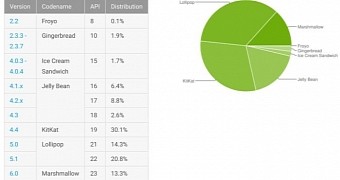Google has released the Android Distribution Chart for July, and the numbers show that Marshmallow 6.0 distribution continues to rise, as are the numbers for Lollipop 5.1. The increase was to be expected, despite the fact that the Mountain View giant will release the latest version of the Android OS, Nougat 7.0, in the coming months.
Google's Android Distribution Numbers for July don't show any surprising stats. On the contrary, Android Marshmallow doesn't seem to perform that well, with the 6.0 version being installed on barely 13.3% of all Android devices, despite the fact that 9 months have passed since it was released, according to Droid-Life.
Still, Marshmallow has managed to rise by 3.2% compared to last month, when it hit the 10.1% mark. However, Marshmallow 6.0 has slightly slowed down its growth compared to the 2.9% rate that it recorded in May's distribution numbers.
Android Lollipop 5.1 distribution has risen 0.8%
Next in line is Android Lollipop, with a total share of 35.1%. Specifically, Lollipop 5.0 is installed on 14.3% of devices while Lollipop 5.1 is featured on 20.8% of handsets. The distribution for Lollipop 5.1 has risen by 0.8% while that for Lollipop 5.0 has dropped 1.1%, meaning that many devices have been upgraded to Lollipop 5.1.
Kitkat 4.4 is featured on 30.1% of devices running Android, but their number has dropped by 1.5% compared to June's distribution chart, which would indicate that some phones have migrated to Lollipop 5.0.
Jelly Bean distribution numbers for July suggest that the Android OS version has become less popular, with a 17.8% share in July compared to 17.8% last month. In addition, Ice Cream Sandwich's share has dropped to 1.7% in July from 1.9% in June, and Gingerbread has seen a slight drop of 0.1% in July.
Froyo 2.2 stagnates at 0.1%, and this version will exit the distribution chart as soon as Android Nougat 7.0 is released. Word is that Google will release the latest Android OS in three months’ time, together with two new Nexus smartphones manufactured by HTC.

 14 DAY TRIAL //
14 DAY TRIAL //